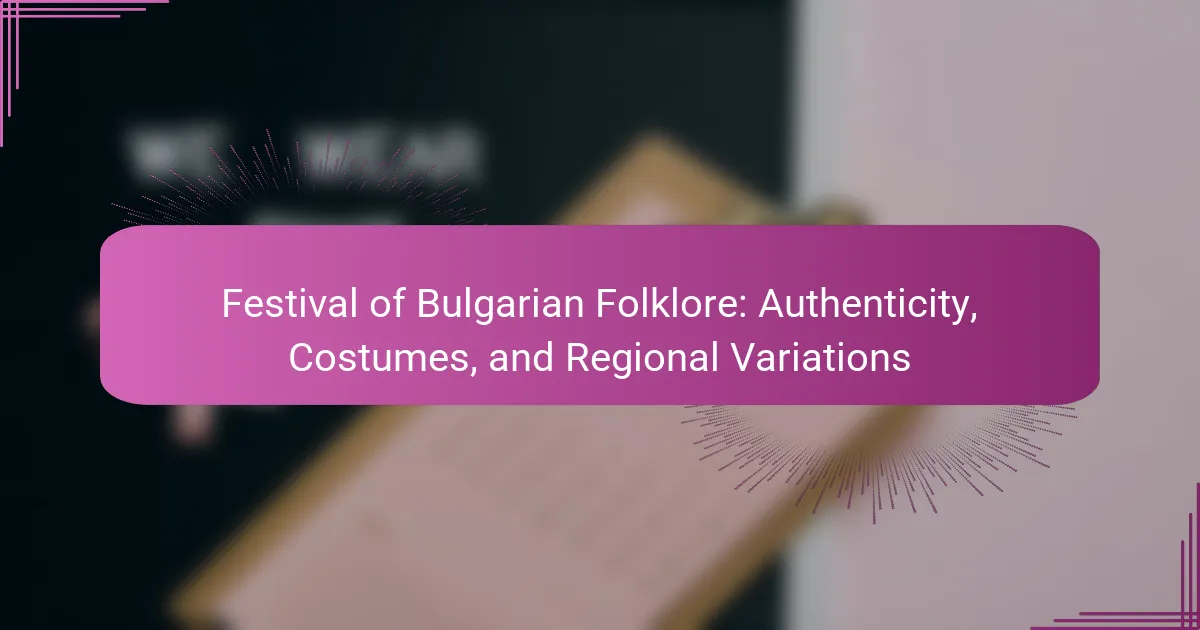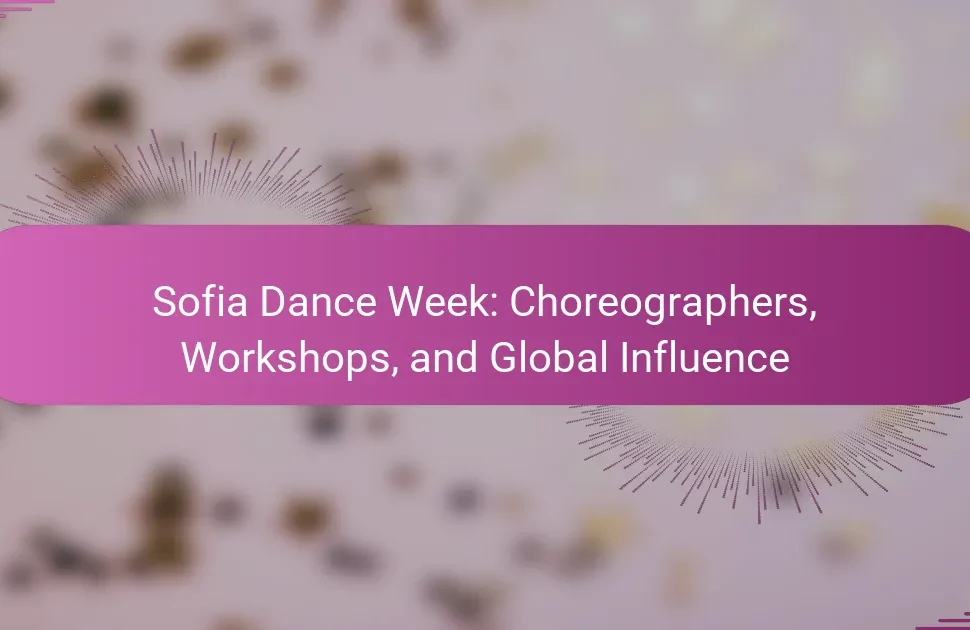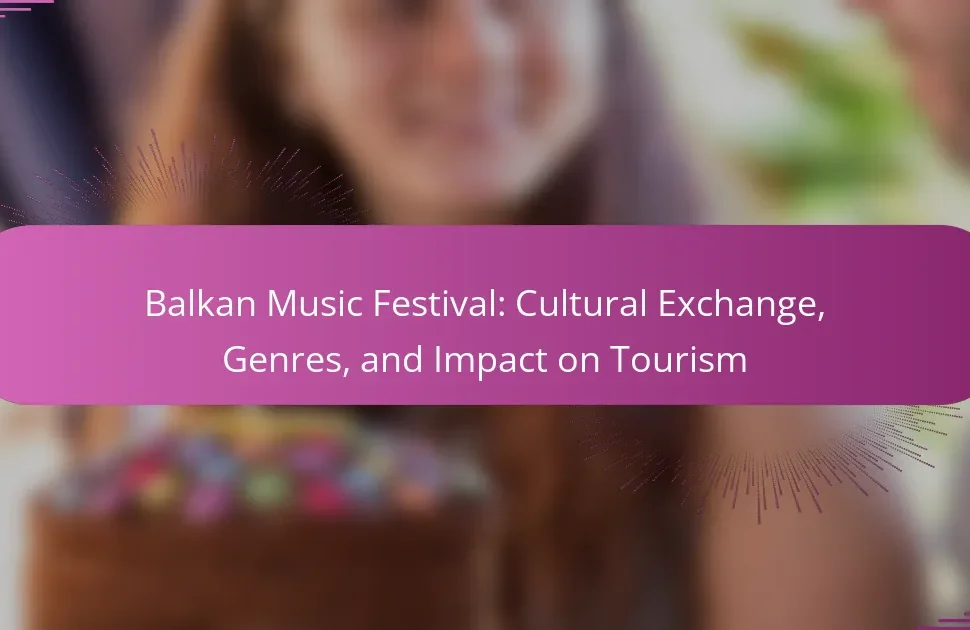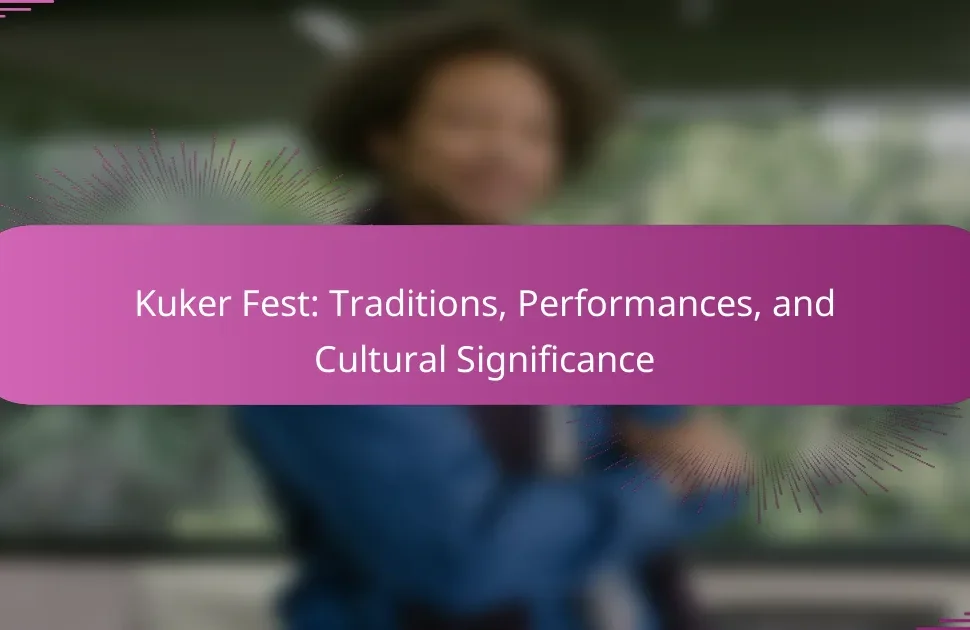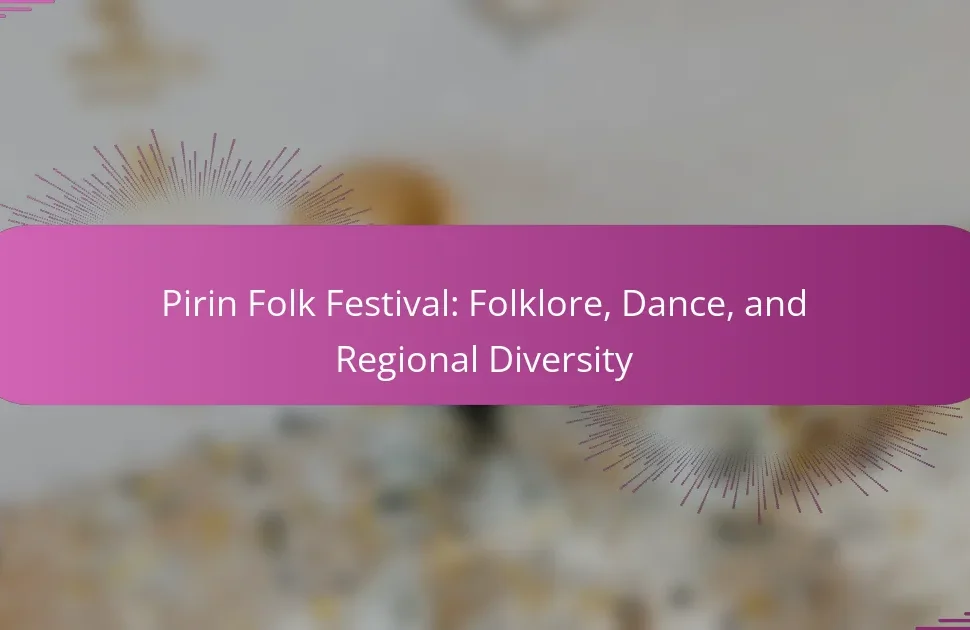The Festival of Bulgarian Folklore celebrates the nation’s rich cultural heritage through traditional music, dance, and vibrant costumes. Authenticity is emphasized, showcasing intricate designs and regional variations. Each region contributes unique elements, enriching the festival experience and preserving local customs. Attendees can engage with performances, workshops, and culinary experiences to deepen their understanding of Bulgarian folklore.
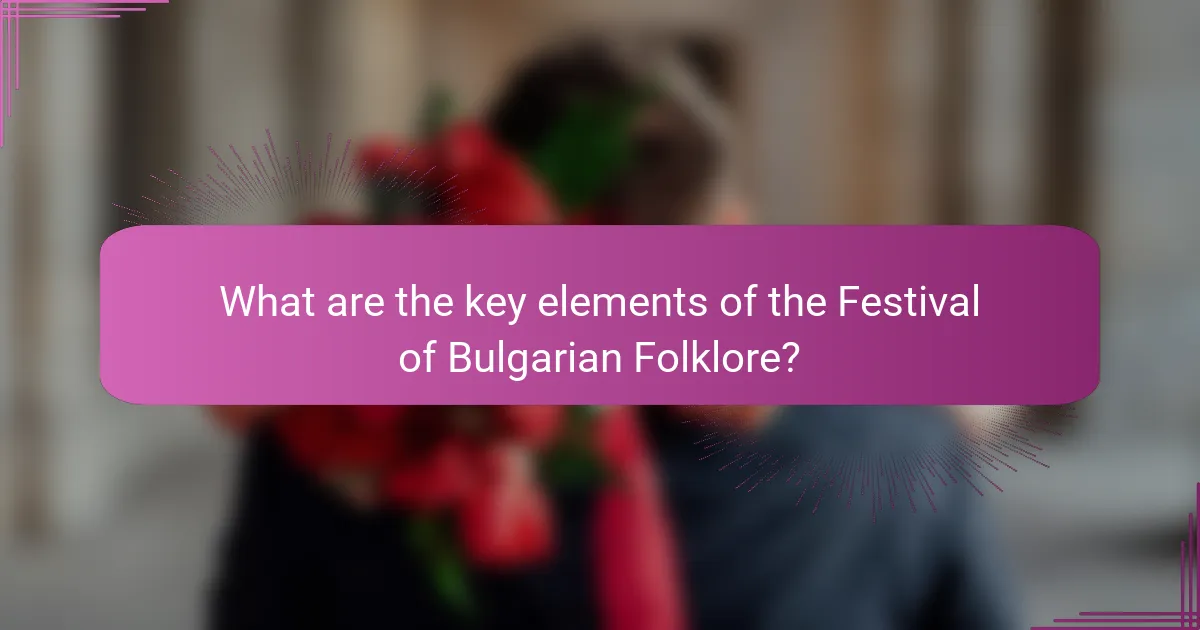
What are the key elements of the Festival of Bulgarian Folklore?
The key elements of the Festival of Bulgarian Folklore include authenticity, vibrant costumes, and diverse regional variations. Authenticity is preserved through traditional music and dance, showcasing Bulgaria’s rich cultural heritage. Costumes reflect local customs, featuring intricate embroidery and distinctive colors. Regional variations highlight the unique folklore of different areas, with each region presenting its own interpretations and styles. These elements together create a vibrant celebration of Bulgarian identity and traditions.
How is authenticity preserved during the festival?
Authenticity during the Festival of Bulgarian Folklore is preserved through strict adherence to traditional practices. Participants wear authentic costumes that reflect regional variations, ensuring cultural representation. Local artisans craft these costumes using age-old techniques, maintaining the festival’s integrity. Additionally, performances are rooted in historical folklore, showcasing original dances and music passed down through generations. This commitment to tradition fosters a genuine celebration of Bulgarian culture.
What role do traditional costumes play in the festival?
Traditional costumes play a vital role in the Festival of Bulgarian Folklore by showcasing cultural heritage. They reflect regional identities and historical narratives, enhancing the festival’s authenticity. Each costume is meticulously crafted, often featuring unique patterns and colors that signify local traditions. The use of traditional attire fosters community pride and strengthens social bonds among participants.
Which regional variations exist within the festival?
The festival of Bulgarian folklore features diverse regional variations characterized by distinct customs, costumes, and music styles. These variations reflect local traditions and cultural influences across different regions.
For example, the Rhodope region emphasizes vocal performances and intricate costumes, while the Shopluk area showcases lively dances and vibrant attire. The Thracian region often highlights folk instruments and unique song patterns. Each area contributes to the festival’s rich tapestry, celebrating Bulgaria’s cultural heritage.
These regional differences enhance the authenticity of the festival, allowing participants to experience a wide array of folkloric expressions. The unique attributes of each region create a dynamic atmosphere that attracts both locals and tourists.
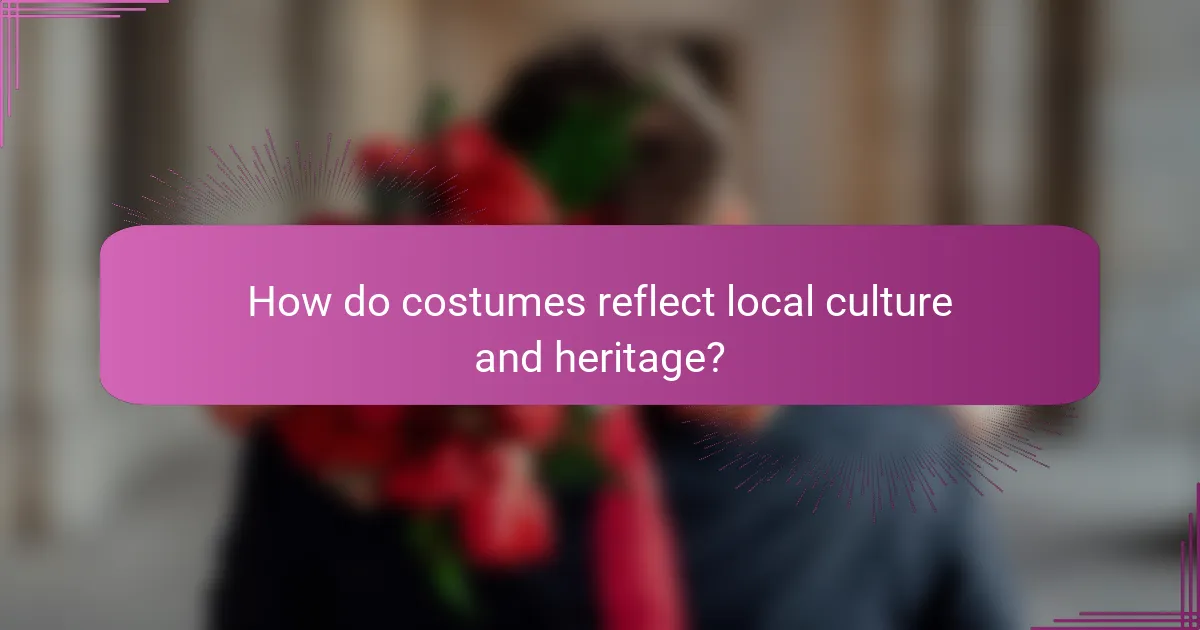
How do costumes reflect local culture and heritage?
Costumes in the Festival of Bulgarian Folklore showcase local culture and heritage through intricate designs and regional variations. Each costume reflects historical influences, local materials, and traditional craftsmanship. For example, the use of vibrant colors and specific patterns can signify a region’s unique identity. Costumes also incorporate symbols representing local myths and folklore, reinforcing cultural narratives. The diversity of styles across Bulgaria highlights the rich tapestry of its heritage, with each region contributing distinct elements to the overall celebration.
What materials are commonly used in traditional costumes?
Traditional costumes often use materials like wool, cotton, and linen. These fabrics provide durability and comfort, essential for the vibrant performances in Bulgarian folklore festivals. Additionally, decorative elements such as embroidery and leather are common, enhancing the cultural authenticity of the costumes. Each region may incorporate unique local materials, reflecting its distinct heritage.
How do colors and patterns signify regional identities?
Colors and patterns in Bulgarian folklore costumes signify regional identities through distinct styles and meanings. Each region employs unique color palettes and motifs that reflect its cultural heritage. For instance, vibrant reds and greens often represent agricultural abundance, while intricate geometric patterns may symbolize local traditions. These visual elements foster a sense of belonging and pride, connecting individuals to their local culture. Regional variations in costumes during festivals highlight the diversity within Bulgarian folklore, showcasing how colors and patterns convey identity and community values.
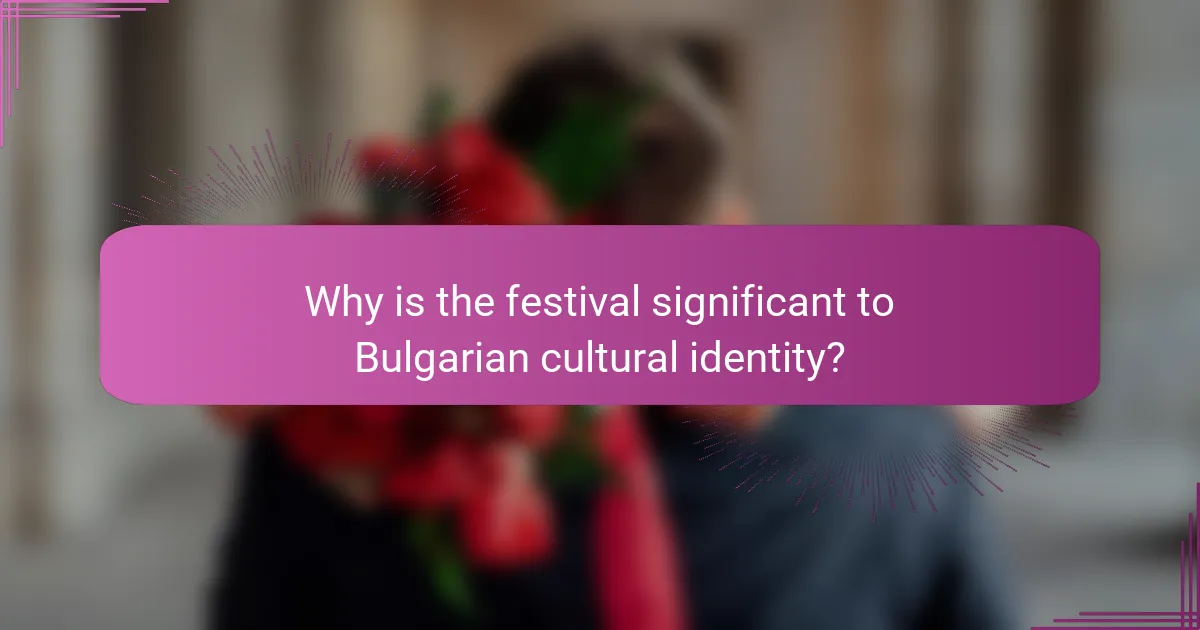
Why is the festival significant to Bulgarian cultural identity?
The Festival of Bulgarian Folklore is significant to Bulgarian cultural identity as it celebrates traditional customs, music, and dance. This festival showcases authentic costumes that reflect regional variations, preserving Bulgaria’s rich heritage. Each region contributes unique elements, fostering a sense of community and continuity. The festival serves as a platform for intergenerational knowledge transfer, ensuring that cultural practices remain vibrant and relevant. Through participation, individuals reinforce their connection to Bulgarian history and identity, making the festival a vital cultural touchstone.
How does the festival promote community engagement?
The festival promotes community engagement by showcasing traditional Bulgarian folklore, fostering local pride, and encouraging participation. Events like workshops and performances invite community members to share their heritage. This interaction strengthens social bonds and enhances cultural awareness. The festival’s emphasis on regional variations highlights the unique attributes of local traditions, creating a sense of belonging among attendees.
What impact does the festival have on tourism?
The Festival of Bulgarian Folklore significantly boosts tourism by attracting visitors interested in authentic cultural experiences. This festival showcases traditional costumes and regional variations, enhancing local economies.
Tourists often seek immersive experiences, and the festival provides a unique opportunity to engage with Bulgarian heritage. For example, the event features folk music, dance, and crafts, drawing both domestic and international attendees.
As a result, local businesses benefit from increased sales in hospitality, crafts, and transportation. The festival’s promotion of cultural tourism positively impacts community identity and pride.
Overall, the festival serves as a vital catalyst for tourism growth, reinforcing the importance of cultural events in enhancing regional economies.
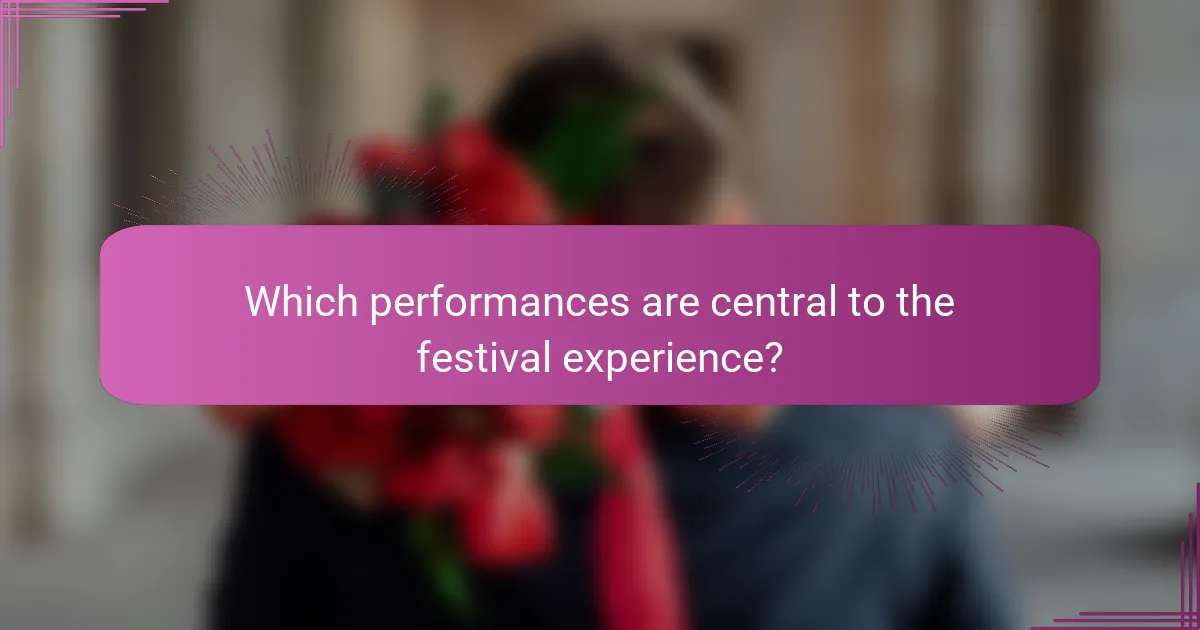
Which performances are central to the festival experience?
Central performances at the Festival of Bulgarian Folklore include traditional dances, music ensembles, and storytelling. These performances highlight authenticity through regional variations in costumes and styles. Folk dances like the Horo showcase communal spirit, while music ensembles feature instruments unique to specific regions. Storytelling preserves folklore, enriching the cultural experience. Each performance reflects the diverse heritage of Bulgaria, making them integral to the festival experience.
How are traditional dances integrated into the festival?
Traditional dances are integral to the Festival of Bulgarian Folklore, showcasing regional variations and cultural authenticity. Each dance reflects unique attributes of local traditions, often performed in traditional costumes that enhance the experience. The festival features a variety of dances, such as the lively Horo and the graceful Rachenitsa, each representing different regions of Bulgaria. These performances foster community spirit and preserve cultural heritage, engaging both participants and audiences in a celebration of Bulgarian identity.
What types of music are featured during the festival?
The festival features a diverse range of traditional Bulgarian music styles. These include folk songs, instrumental performances, and regional variations that reflect Bulgaria’s rich cultural heritage. Popular genres showcased are “horo” dances, “ruchenitsa,” and “kopanitsa,” each with unique rhythms and melodies. Performers often wear authentic costumes that enhance the cultural experience.
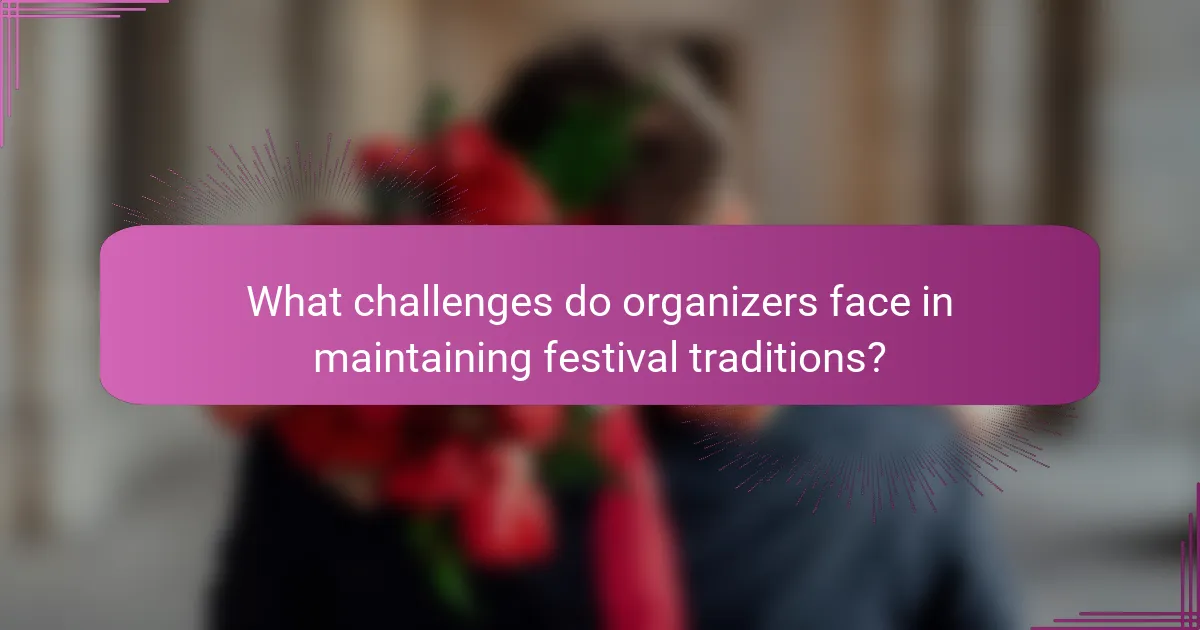
What challenges do organizers face in maintaining festival traditions?
Organizers face several challenges in maintaining festival traditions, including authenticity, financial constraints, and regional variations. Authenticity is crucial for preserving cultural heritage, yet it can be difficult to balance with modern influences. Financial limitations often restrict the ability to source traditional costumes and materials, impacting the overall presentation of the festival. Additionally, regional variations in folklore can complicate standardization, leading to disputes over representation and authenticity. These challenges require careful negotiation between tradition and contemporary demands to ensure the festival remains relevant and true to its roots.
How does modernization affect the festival’s authenticity?
Modernization can compromise the authenticity of the Festival of Bulgarian Folklore by introducing commercial elements. Traditional practices may be altered to appeal to tourists, leading to a loss of cultural significance. Costumes may become less representative of regional variations, as mass-produced items replace handmade garments. Additionally, the focus on entertainment can overshadow the festival’s educational aspects, diminishing its role in preserving folklore.
What strategies are employed to attract younger audiences?
Festivals of Bulgarian folklore attract younger audiences through immersive experiences, social media engagement, and interactive workshops. Authenticity in costumes and regional variations enhances relatability. Collaborations with influencers also draw interest, making traditions appealing and accessible.
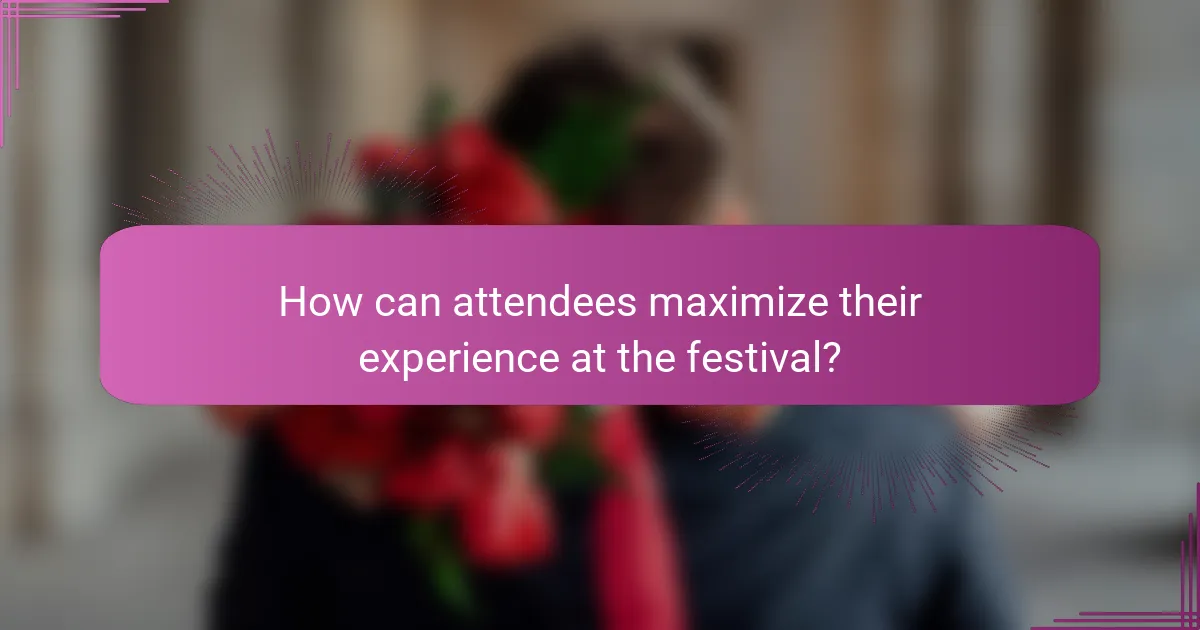
How can attendees maximize their experience at the festival?
Attendees can maximize their experience at the Festival of Bulgarian Folklore by engaging deeply with the cultural offerings. Explore authentic costumes and participate in regional dance workshops to appreciate the diversity within Bulgarian folklore.
Plan your visit around key performances showcasing traditional music, as these highlight unique regional variations. Interact with artisans to learn about the craftsmanship behind costumes, enhancing your understanding of their significance.
Taking part in local culinary experiences will also enrich your festival journey, allowing you to taste traditional dishes that reflect the culture’s heritage. Engage with fellow attendees to share insights and experiences, fostering a sense of community.
What should visitors know before attending?
Visitors should know that the Festival of Bulgarian Folklore showcases authentic costumes, music, and regional variations. Attendees should prepare for a vibrant atmosphere filled with traditional performances. It’s advisable to research specific regional styles to appreciate the diversity. The festival often features workshops, allowing visitors to engage with the culture hands-on. Additionally, attendees should consider the cost of entry and any potential travel expenses.
Which etiquette practices should be observed during the festival?
Observing proper etiquette during the Festival of Bulgarian Folklore enhances the experience for everyone involved. Attendees should respect local customs, engage with performers respectfully, and dress appropriately in traditional costumes.
1. Acknowledge cultural significance: Understand the history and meaning behind the festival’s rituals and performances.
2. Dress in traditional attire: Wearing authentic costumes shows appreciation for the culture and enhances the festival atmosphere.
3. Participate actively: Join in dances and activities to foster community spirit and enjoyment.
4. Respect personal space: Maintain a respectful distance from performers and participants to ensure comfort.
5. Follow photography rules: Always ask for permission before taking photos of individuals or performances to honor their privacy.
What are common mistakes to avoid at the festival?
To avoid common mistakes at the Festival of Bulgarian Folklore, prioritize authenticity in costumes and respect regional variations. Ensure your attire reflects the true cultural heritage, as misrepresentations can lead to misunderstandings. Familiarize yourself with local customs and practices to enhance your experience and connection with the festival. Additionally, engage with local artisans and performers to appreciate the nuances of the folklore being showcased.
